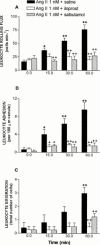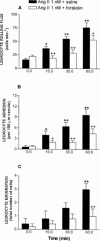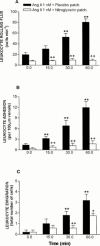Cyclic AMP elevating agents and nitric oxide modulate angiotensin II-induced leukocyte-endothelial cell interactions in vivo
- PMID: 11399665
- PMCID: PMC1572808
- DOI: 10.1038/sj.bjp.0704096
Cyclic AMP elevating agents and nitric oxide modulate angiotensin II-induced leukocyte-endothelial cell interactions in vivo
Abstract
Angiotensin (Ang-II) is a key molecule in the development of cardiac ischaemic disorders and displays proinflammatory activity in vivo. Since intracellular cyclic nucleotides elevating agents have proved to be effective modulators of leukocyte recruitment, we have evaluated their effect on Ang-II-induced leukocyte-endothelial cell interactions in vivo using intravital microscopy within the rat mesenteric microcirculation. Pretreatment with iloprost significantly inhibited (1 nM) Ang-II-induced increase in leukocyte rolling flux, adhesion and emigration at 60 min by 96, 92 and 90% respectively, and returned leukocyte rolling velocity to basal levels. Pretreatment with salbutamol or co-superfusion with forskolin exerted similar effects. When theophylline was administered, leukocyte rolling flux, adhesion and emigration elicited by Ang-II were significantly attenuated by 81, 89 and 71% respectively. Rolipram administration caused similar reduction of Ang-II-induced leukocyte responses. Co-superfusion of Ang-II with the NO-donor, spermine-NO, or 8-Br-cyclic GMP, or pretreatment with a transdermal nytroglycerin patch, resulted in a significant reduction of the leukocyte-endothelial cell interactions elicited by Ang-II. Salbutamol preadministration did not modify leukocyte-endothelial cell interactions elicited by either L-NAME or L-NAME+Ang-II, indicating that the inhibitory leukocyte effects caused by cyclic AMP-elevating agents are mediated through NO release. In conclusion, we have provided evidence that cyclic AMP elevating agents and NO donors, are potent inhibitors of Ang-II-induced leukocyte-endothelial cell interactions. Thus, they could constitute a powerful therapeutical tool in the control of the leukocyte recruitment characteristic of the vascular lesions that occur in cardiovascular disease states where Ang-II plays a critical role.
Figures






References
-
- ALTENBURG S.P., BOZZA P.T., MARTINS M.A., TIBIRICA E.V., SILVA P.M., CORDEIRO R.S., CASTRO-FARIA-NETO H.C. Adrenergic modulation of the blood neutrophilia induced by platelet activating factor in rats. Eur. J. Pharmacol. 1994;256:45–49. - PubMed
-
- ARNDT H., RUSSELL J.B., KUROSE I., KUBES P., GRANGER D.N. Mediators of leukocyte adhesion in rat mesenteric venules elicited by inhibition of nitric oxide synthesis. Gastroenterology. 1993;105:675–680. - PubMed
-
- BADIMON J.J., FUSTER V., CHESEBRO J.H., BADIMON L. Coronary atherosclerosis. A multifactorial disease. Circulation. 1993;87:II3–II16. - PubMed
-
- BERENDS C., DIJKHUIZEN B., DE MONCHY J.G., DUBOIS A.E., GERRITSEN J., KAUFFMAN H.F. Inhibition of PAF-induced expression of CD11b and shedding of L-selectin on human neutrophils and eosinophils by the type IV selective PDE inhibitor, rolipram. Eur. Respir. J. 1997;10:1000–1007. - PubMed
Publication types
MeSH terms
Substances
LinkOut - more resources
Full Text Sources
Miscellaneous

